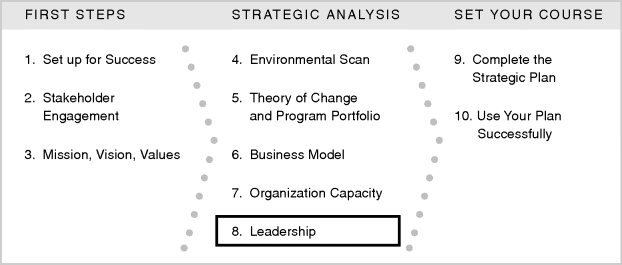Chapter 8Step 8: Leadership

Leadership is central to any organization's success, and there may be more management books and articles written about leadership than all other aspects of organizational effectiveness combined. A brilliant, well-funded strategy with adequate resources cannot be successfully executed without shared, clear vision and direction—something the top leadership needs to accomplish. But how? And how does one know when good leadership is taking place?
Our approach to leadership refers to the broad notion of the leadership function, as well as to the effectiveness of individuals in specific roles, starting with the board president and the executive director. The simplest definition of leadership is “mobilizing others to take action.” Leadership in this broader sense includes the work carried out individually and collectively by staff and board members.
One of the most famous books on leadership, The Leadership Challenge, by Jim Kouzes and Barry Posner, now in its fifth edition, identifies five practices and several attributes of exemplary leadership. The five practices of exemplary leadership are as follows:
- Model the way
- Inspire a shared vision
- Challenge the process
- Enable others to act
- Encourage the heart
There also are attributes we look for and admire in leaders, according to Kouzes and Posner. Such leaders are:
- Honest—This is the single most important ...
Get Strategic Planning for Nonprofit Organizations: A Practical Guide for Dynamic Times, 3rd Edition now with the O’Reilly learning platform.
O’Reilly members experience books, live events, courses curated by job role, and more from O’Reilly and nearly 200 top publishers.

